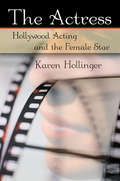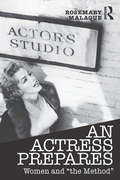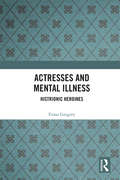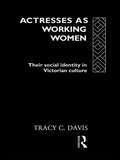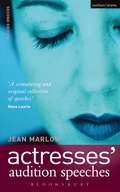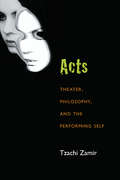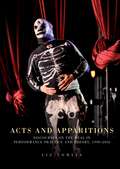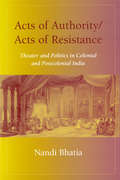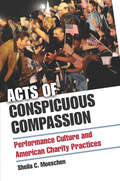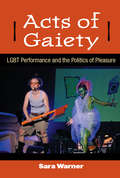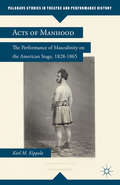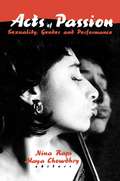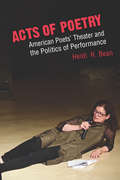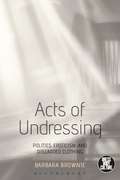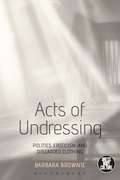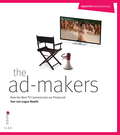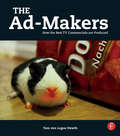- Table View
- List View
The Actress: Hollywood Acting and the Female Star
by Karen HollingerThe Actress: Hollywood Acting and the Female Star investigates the contemporary film actress both as an artist and as an ideological construct. Divided into two sections, The Actress first examines the major issues in studying film acting, stardom, and the Hollywood actress. Combining theories of screen acting and of film stardom, The Actress presents a synthesis of methodologies and offers the student and scholar a new approach to these two subjects of study.
The Actress: Hollywood Acting and the Female Star
by Karen HollingerThe Actress: Hollywood Acting and the Female Star investigates the contemporary film actress both as an artist and as an ideological construct. Divided into two sections, The Actress first examines the major issues in studying film acting, stardom, and the Hollywood actress. Combining theories of screen acting and of film stardom, The Actress presents a synthesis of methodologies and offers the student and scholar a new approach to these two subjects of study.
An Actress Prepares: Women and "the Method"
by Rosemary Malague'Every day, thousands of women enter acting classes where most of them will receive some variation on the Stanislavsky-based training that has now been taught in the U.S. for nearly ninety years. Yet relatively little feminist consideration has been given to the experience of the student actress: What happens to women in Method actor training?' An Actress Prepares is the first book to interrogate Method acting from a specifically feminist perspective. Rose Malague addresses "the Method" not only with much-needed critical distance, but also the crucial insider's view of a trained actor. Case studies examine the preeminent American teachers who popularized and transformed elements of Stanislavsky’s System within the U.S.—Strasberg, Adler, Meisner, and Hagen— by analyzing and comparing their related but distinctly different approaches. This book confronts the sexism that still exists in actor training and exposes the gender biases embedded within the Method itself. Its in-depth examination of these Stanislavskian techniques seeks to reclaim Method acting from its patriarchal practices and to empower women who act. 'I've been waiting for someone to write this book for years: a thorough-going analysis and reconsideration of American approaches to Stanislavsky from a feminist perspective ... lively, intelligent, and engaging.' – Phillip Zarrilli, University of Exeter 'Theatre people of any gender will be transformed by Rose Malague’s eye-opening study An Actress Prepares... This book will be useful to all scholars and practitioners determined to make gender equity central to how they hone their craft and their thinking.' – Jill Dolan, Princeton University
An Actress Prepares: Women and "the Method"
by Rosemary Malague'Every day, thousands of women enter acting classes where most of them will receive some variation on the Stanislavsky-based training that has now been taught in the U.S. for nearly ninety years. Yet relatively little feminist consideration has been given to the experience of the student actress: What happens to women in Method actor training?' An Actress Prepares is the first book to interrogate Method acting from a specifically feminist perspective. Rose Malague addresses "the Method" not only with much-needed critical distance, but also the crucial insider's view of a trained actor. Case studies examine the preeminent American teachers who popularized and transformed elements of Stanislavsky’s System within the U.S.—Strasberg, Adler, Meisner, and Hagen— by analyzing and comparing their related but distinctly different approaches. This book confronts the sexism that still exists in actor training and exposes the gender biases embedded within the Method itself. Its in-depth examination of these Stanislavskian techniques seeks to reclaim Method acting from its patriarchal practices and to empower women who act. 'I've been waiting for someone to write this book for years: a thorough-going analysis and reconsideration of American approaches to Stanislavsky from a feminist perspective ... lively, intelligent, and engaging.' – Phillip Zarrilli, University of Exeter 'Theatre people of any gender will be transformed by Rose Malague’s eye-opening study An Actress Prepares... This book will be useful to all scholars and practitioners determined to make gender equity central to how they hone their craft and their thinking.' – Jill Dolan, Princeton University
Actresses and Mental Illness: Histrionic Heroines (Interdisciplinary Research in Gender)
by Fiona GregoryActresses and Mental Illness investigates the relationship between the work of the actress and her personal experience of mental illness, from the late nineteenth through to the end of twentieth century. Over the past two decades scholars have made great advances in our understanding of the history of the actress, unearthing the material conditions of her working life, the force of her creative agency and the politics of her reception and representation. By focusing specifically on actresses’ encounters with mental illness, Fiona Gregory builds on this earlier work and significantly supplements it. Through detailed case studies of both well-known and neglected figures in theatre and film history, including Mrs Patrick Campbell, Vivien Leigh, Frances Farmer and Diana Barrymore, it shows how mental illness – actual or supposed – has impacted on actresses’ performances, careers and celebrity. The book covers a range of topics including: representing emotion on stage; the ‘failed’ actress; actresses and addiction; and actresses and psychiatric treatment. Actresses and Mental Illness expands the field of actress studies by showing how consideration of the personal experience of the actress influences our understanding of her work and its reception. The book underscores how the actress can be perceived as a representative public woman, acting as a lens through which we can examine broader attitudes to women and mental illness.
Actresses and Mental Illness: Histrionic Heroines (Interdisciplinary Research in Gender)
by Fiona GregoryActresses and Mental Illness investigates the relationship between the work of the actress and her personal experience of mental illness, from the late nineteenth through to the end of twentieth century. Over the past two decades scholars have made great advances in our understanding of the history of the actress, unearthing the material conditions of her working life, the force of her creative agency and the politics of her reception and representation. By focusing specifically on actresses’ encounters with mental illness, Fiona Gregory builds on this earlier work and significantly supplements it. Through detailed case studies of both well-known and neglected figures in theatre and film history, including Mrs Patrick Campbell, Vivien Leigh, Frances Farmer and Diana Barrymore, it shows how mental illness – actual or supposed – has impacted on actresses’ performances, careers and celebrity. The book covers a range of topics including: representing emotion on stage; the ‘failed’ actress; actresses and addiction; and actresses and psychiatric treatment. Actresses and Mental Illness expands the field of actress studies by showing how consideration of the personal experience of the actress influences our understanding of her work and its reception. The book underscores how the actress can be perceived as a representative public woman, acting as a lens through which we can examine broader attitudes to women and mental illness.
Actresses as Working Women: Their Social Identity in Victorian Culture (Gender in Performance)
by Tracy C. DavisUsing historical evidence as well as personal accounts, Tracy C. Davis examines the reality of conditions for `ordinary' actresses, their working environments, employment patterns and the reasons why acting continued to be such a popular, though insecure, profession. Firmly grounded in Marxist and feminist theory she looks at representations of women on stage, and the meanings associated with and generated by them.
Actresses as Working Women: Their Social Identity in Victorian Culture (Gender in Performance)
by Tracy C. DavisUsing historical evidence as well as personal accounts, Tracy C. Davis examines the reality of conditions for `ordinary' actresses, their working environments, employment patterns and the reasons why acting continued to be such a popular, though insecure, profession. Firmly grounded in Marxist and feminist theory she looks at representations of women on stage, and the meanings associated with and generated by them.
Actresses' Audition Speeches (Audition Speeches)
by Jean MarlowFinding good, interesting audition pieces is a demanding and difficult process for actresses. This revised edition of Actresses' Audition Speeches contains over 40 speeches and includes a wide selection of pieces taken from plays written or produced recently, such as Losing Louis, Whose Life is it Anyway? and His Dark Materials. There are speeches for a variety of accents and ages, taken from both classical and modern plays, to suit all audition requirements. There is also an introductory section containing advice from directors and casting directors on how to audition successfully.
Actresses' Audition Speeches: 50+ Audition Pieces For Actors And Actresses (Audition Speeches)
by Jean MarlowFinding good, interesting audition pieces is a demanding and difficult process for actresses. This revised edition of Actresses' Audition Speeches contains over 40 speeches and includes a wide selection of pieces taken from plays written or produced recently, such as Losing Louis, Whose Life is it Anyway? and His Dark Materials. There are speeches for a variety of accents and ages, taken from both classical and modern plays, to suit all audition requirements. There is also an introductory section containing advice from directors and casting directors on how to audition successfully.
Acts: Theater, Philosophy, and the Performing Self (Theater: Theory/Text/Performance)
by Tzachi ZamirWhy do people act? Why are other people drawn to watch them? How is acting as a performing art related to role-playing outside the theater? As the first philosophical study devoted to acting, Acts: Theater, Philosophy, and the Performing Selfsheds light on some of the more evasive aspects of the acting experience— such as the import of the actor's voice, the ethical unease sometimes felt while embodying particular sequences, and the meaning of inspiration. Tzachi Zamir explores acting’s relationship to everyday role-playing through a surprising range of examples of “lived acting,” including pornography, masochism, and eating disorders. By unearthing the deeper mobilizing structures that underlie dissimilar forms of staged and non-staged role-playing, Acts offers a multi-layered meditation on the percolation from acting to life. The book engages questions of theatrical inspiration, the actor’s “energy,” the difference between acting and pretending, the special role of repetition as part of live acting, the audience and its attraction to acting, and the unique significance of the actor’s voice. It examines the embodied nature of the actor’s animation of a fiction, the breakdown of the distinction between what one acts and who one is, and the transition from what one performs into who one is, creating an interdisciplinary meditation on the relationship between life and acting.
Acts and apparitions: Discourses on the real in performance practice and theory, 1990–2010
by Elizabeth TomlinActs and apparitions examines how new performance practices from the 1990s and the present day have been driven by questions of the real and the ensuing political implications of the concept's rapidly disintegrating authority.
Acts of Authority/Acts of Resistance: Theater and Politics in Colonial and Postcolonial India
by Nandi BhatiaDespite its importance to literary and cultural texts of resistance, theater has been largely overlooked as a field of analysis in colonial and postcolonial studies. Acts of Authority/Acts of Resistance seeks to address that absence, as it uniquely views drama and performance as central to the practice of nationalism and anti-colonial resistance. Nandi Bhatia argues that Indian theater was a significant force in the struggle against oppressive colonial and postcolonial structures, as it sought to undo various schemes of political and cultural power through its engagement with subjects derived from mythology, history, and available colonial models such as Shakespeare. Bhatia's attention to local histories within a postcolonial framework places performance in a global and transcultural context. Drawing connections between art and politics, between performance and everyday experience, Bhatia shows how performance often intervened in political debates and even changed the course of politics. One of the first Western studies of Indian theater to link the aesthetics and the politics of that theater, Acts of Authority/Acts of Resistance combines in-depth archival research with close readings of dramatic texts performed at critical moments in history. Each chapter amplifies its themes against the backdrop of specific social conditions as it examines particular dramatic productions, from The Indigo Mirror to adaptations of Shakespeare plays by Indian theater companies, illustrating the role of theater in bringing nationalist, anticolonial, and gendered struggles into the public sphere. Nandi Bhatia is Associate Professor of English at the University of Western Ontario.
Acts of Conspicuous Compassion: Performance Culture and American Charity Practices
by Sheila C MoeschenCharity has been a pervasive and influential concept in American culture, and has also served an important ideological purpose, helping people articulate their sense of individual and national identity. But what, exactly, compels our benevolence? In a social moment when countless worthy causes and deserving groups clamor for attention, it is worth examining how our culture generates the exchange of sympathy commonly experienced as “charity.” Acts of Conspicuous Compassion investigates the historical and continuing relationship between performance culture and the cultivation of charitable sentiment, exploring the distinctive practices that have evolved to make the plea for charity legible and compelling. From the work of 19th-century melodramas to the televised drama of transformation and redemption in reality TV’s Extreme Makeover: Home Edition, the book charts the sophisticated strategies that various charity movements have employed to make organized benevolence seem attractive, exciting, and seemingly uncomplicated. Sheila C. Moeschen sheds new light on the legacy and involvement of disabled people within charity—specifically, the articulation of performance culture as a vital theoretical framework for discussing issues of embodiment and identity, a framework that dislodges previously held notions of the disabled existing as passive “objects” of pity. This work gives rise to a more complicated and nuanced discussion of the participation of the disabled community in the charity industry, of the opportunities afforded by performance culture for disabled people to act as critical agents of charity, and of the new ethical and political issues that arise from employing performance methodology in a culture with increased appetites for voyeurism, display, and complex spectacle.
Acts of Gaiety: LGBT Performance and the Politics of Pleasure (Triangulations: Lesbian/Gay/Queer Theater/Drama/Performance)
by Sara WarnerAgainst queer theory's long-suffering romance with mourning and melancholia and a national agenda that urges homosexuals to renounce pleasure if they want to be taken seriously, Acts of Gaiety seeks to reanimate notions of "gaiety" as a political value for LGBT activism by recovering earlier mirthful modes of political performance. The book mines the archives of lesbian-feminist activism of the 1960s–70s, highlighting the outrageous gaiety—including camp, kitsch, drag, guerrilla theater, zap actions, rallies, manifestos, pageants, and parades alongside "legitimate theater”-- at the center of the social and theatrical performances of the era. Juxtaposing figures such as Valerie Solanas and Jill Johnston with more recent performers and activists including Hothead Paisan, Bitch and Animal, and the Five Lesbian Brothers, Sara Warner shows how reclaiming this largely discarded and disavowed past elucidates possibilities for being and belonging. Acts of Gaiety explores the mutually informing histories of gayness as politics and as joie de vivre, along with the centrality of liveliness to queer performance and protest.
Acts of Manhood: The Performance of Masculinity on the American Stage, 1828–1865 (Palgrave Studies in Theatre and Performance History)
by K. KippolaExploring the performance of masculinity on and off the nineteenth-century American stage, this book looks at the shift from the passionate muscularity to intellectual restraint as not a linear journey toward national refinement; but a multitude of masculinities fighting simultaneously for dominance and recognition.
Acts of Passion: Sexuality, Gender, and Performance
by Nina Rapi Maya ChowdhryThe first volume to focus exclusively on lesbian performance work, Acts of Passion: Sexuality, Gender, and Performance draws on the experiences and expertise of a wide range of lesbian practitioners and theorists to explore the impact and influences of sexuality and gender on performance. It examines essays, dialogues, and performance texts from theater directors, performers, theorists, playwrights, and performance writers against social and cultural constructs and performance theories to produce a diverse and challenging portrait of lesbian live performance art. The book’s penetrating scope covers drag queens, lesbian vampires, representations of lesbian sex, solo artists, the art of collaboration, lesbian aesthetics, and lesbian playwrights writing straight and illustrates why live performance is one of the most dynamic forums in which women can create, control, and produce their work without artistic constraint.Acts of Passion explodes binary definitions of gender and sexuality by destabilizing familiar notions of the ‘real’and creating new production values and aesthetics in the process. The relationships between experience and expression, sexuality and cultural placing, context and artistic control, representation and self-representation become clearer as the book discusses: the manner in which women are represented as absent in the signifying system of patriarchal society how questions of purity, ‘authenticity,’and self-definition complicate the field of representation the power of lesbian dance performance to make the lesbian body culturally visible several ‘new wave’performers--creating work, getting seen, showing flesh, doing politics, and making money the projections, preconceptions, expectations, and general baggage attached to the performing lesbian body what the term ‘lesbian playwright’means within contemporary culture ‘It’s Queer Up North’--a British National Arts Organization the arguments for and against mainstreaming lesbian performanceAnyone interested in theater and performance, cultural studies, gender issues, and the politics of ‘positive representation’--whether playwright, performer, director, writer, academic, student, or theatre goer--will find Acts of Passion a powerful step in wrenching the power of representation away from the dominant culture. Defiant, saucy, sexy, and smart, the contributors appropriate their own spaces, identities, crafts, and languages, both within this book and without.
Acts of Passion: Sexuality, Gender, and Performance
by Nina Rapi Maya ChowdhryThe first volume to focus exclusively on lesbian performance work, Acts of Passion: Sexuality, Gender, and Performance draws on the experiences and expertise of a wide range of lesbian practitioners and theorists to explore the impact and influences of sexuality and gender on performance. It examines essays, dialogues, and performance texts from theater directors, performers, theorists, playwrights, and performance writers against social and cultural constructs and performance theories to produce a diverse and challenging portrait of lesbian live performance art. The book’s penetrating scope covers drag queens, lesbian vampires, representations of lesbian sex, solo artists, the art of collaboration, lesbian aesthetics, and lesbian playwrights writing straight and illustrates why live performance is one of the most dynamic forums in which women can create, control, and produce their work without artistic constraint.Acts of Passion explodes binary definitions of gender and sexuality by destabilizing familiar notions of the ‘real’and creating new production values and aesthetics in the process. The relationships between experience and expression, sexuality and cultural placing, context and artistic control, representation and self-representation become clearer as the book discusses: the manner in which women are represented as absent in the signifying system of patriarchal society how questions of purity, ‘authenticity,’and self-definition complicate the field of representation the power of lesbian dance performance to make the lesbian body culturally visible several ‘new wave’performers--creating work, getting seen, showing flesh, doing politics, and making money the projections, preconceptions, expectations, and general baggage attached to the performing lesbian body what the term ‘lesbian playwright’means within contemporary culture ‘It’s Queer Up North’--a British National Arts Organization the arguments for and against mainstreaming lesbian performanceAnyone interested in theater and performance, cultural studies, gender issues, and the politics of ‘positive representation’--whether playwright, performer, director, writer, academic, student, or theatre goer--will find Acts of Passion a powerful step in wrenching the power of representation away from the dominant culture. Defiant, saucy, sexy, and smart, the contributors appropriate their own spaces, identities, crafts, and languages, both within this book and without.
Acts of Poetry: American Poets' Theater and the Politics of Performance
by Heidi R BeanAmerican poets’ theater emerged in the postwar period alongside the rich, performance-oriented poetry and theater scenes that proliferated on the makeshift stages of urban coffee houses, shared apartments, and underground theaters, yet its significance has been largely overlooked by critics. Acts of Poetry shines a spotlight on poets’ theater’s key groups, practitioners, influencers, and inheritors, such as the Poets’ Theatre, the Living Theatre, Gertrude Stein, Bunny Lang, Frank O’Hara, Amiri Baraka, Carla Harryman, and Suzan-Lori Parks. Heidi R. Bean demonstrates the importance of poets’ theater in the development of twentieth-century theater and performance poetry, and especially evolving notions of the audience’s role in performance, and in narratives of the relationship between performance and everyday life. Drawing on an extensive archive of scripts, production materials, personal correspondence, theater records, interviews, manifestoes, editorials, and reviews, the book captures critical assessments and behind-the-scenes discussions that enrich our understanding of the intertwined histories of American theater and American poetry in the twentieth century.
Acts of Undressing: Politics, Eroticism, and Discarded Clothing (Dress, Body, Culture)
by Barbara BrownieThe act of undressing has a multitude of meanings, which vary dramatically when this commonly private gesture is presented for public consumption. This ground-breaking book explores the significance of undressing in various cultural and social contexts.As we are increasingly obsessed with dress choices as signifiers of who we are and how we feel, an investigation into what happens as we remove our clothes has never been more pertinent. Exploring three main issues - politics, tease, and clothes without bodies - Acts of Undressing discusses these key themes through an in-depth and eclectic mix of case studies including flashing at Mardi Gras, the World Burlesque Games, and 'shoefiti' used by gangs to mark territories.Building on leading theories of dress and the body, from academics including Roland Barthes and Mario Perniolato, Ruth Barcan and Erving Goffman, Acts of Undressing is essential reading for students of fashion, sociology, anthropology, visual culture, and related subjects.
Acts of Undressing: Politics, Eroticism, and Discarded Clothing (Dress, Body, Culture)
by Barbara BrownieThe act of undressing has a multitude of meanings, which vary dramatically when this commonly private gesture is presented for public consumption. This ground-breaking book explores the significance of undressing in various cultural and social contexts.As we are increasingly obsessed with dress choices as signifiers of who we are and how we feel, an investigation into what happens as we remove our clothes has never been more pertinent. Exploring three main issues - politics, tease, and clothes without bodies - Acts of Undressing discusses these key themes through an in-depth and eclectic mix of case studies including flashing at Mardi Gras, the World Burlesque Games, and 'shoefiti' used by gangs to mark territories.Building on leading theories of dress and the body, from academics including Roland Barthes and Mario Perniolato, Ruth Barcan and Erving Goffman, Acts of Undressing is essential reading for students of fashion, sociology, anthropology, visual culture, and related subjects.
The Ad Makers: How the Best TV Commercials are Produced (Creative Professional Ser.)
by Tom von NewthThe Ad-Makers looks at the cinematic form where commerce and creativity collide most dramatically: the TV commercial.Featuring interviews from top professionals in the field, the book provides the kind of behind-the-scenes expertise that it usually takes a lifetime of professional practice to acquire.Gathered from the disciplines of cinematography, directing, producing and editing, the filmmakers tell the stories behind the making of some of the world's top commercials. Each chapter includes an overview of best practice and a host of images-stills from the spots themselves and concept visuals.Exploring the creative process from conception to post-production, The Ad-Makers also covers developments within the industry precipitated by the digital age and the new challenges placed on ad-making by the explosion of social media.With special focus on the shooting and production elements of making a television advert, this book is ideal for all filmmakers who want to build a career in advertising, or, as is increasingly common, feature films.- The stories behind some of the best-known TV commercials, as told by the people who made them- Top producers, designers, storyboarders, directors, editors and visual effects creatives reveal the secrets of the television advertising industry
The Ad-Makers: How the Best TV Commercials are Produced (Creative Professional Ser.)
by Tom von Logue NewthThe Ad-Makers looks at the cinematic form where commerce and creativity collide most dramatically: the TV commercial. Featuring interviews from top professionals in the field, the book provides the kind of behind-the-scenes expertise that it usually takes a lifetime of professional practice to acquire. Gathered from the disciplines of cinematography, directing, producing, and editing, the filmmakers tell the stories behind the making of some of the world’s top commercials. Each chapter includes an overview of best practice and a host of images—stills from the spots themselves and concept visuals. Exploring the creative process from conception to post-production, The Ad-Makers also covers developments within the industry precipitated by the digital age and the new challenges placed on ad-making by the explosion of social media. With special focus on the shooting and production elements of making a television advert, this book is ideal for all filmmakers who want to build a career in advertising or even feature films. • The stories behind some of the best-known TV commercials, as told by the people who made them • Top producers, designers, storyboarders, directors, editors, and visual effects creatives reveal the secrets of the television advertising industry
The Ad-Makers: How the Best TV Commercials are Produced
by Tom von Logue NewthThe Ad-Makers looks at the cinematic form where commerce and creativity collide most dramatically: the TV commercial. Featuring interviews from top professionals in the field, the book provides the kind of behind-the-scenes expertise that it usually takes a lifetime of professional practice to acquire. Gathered from the disciplines of cinematography, directing, producing, and editing, the filmmakers tell the stories behind the making of some of the world’s top commercials. Each chapter includes an overview of best practice and a host of images—stills from the spots themselves and concept visuals. Exploring the creative process from conception to post-production, The Ad-Makers also covers developments within the industry precipitated by the digital age and the new challenges placed on ad-making by the explosion of social media. With special focus on the shooting and production elements of making a television advert, this book is ideal for all filmmakers who want to build a career in advertising or even feature films. • The stories behind some of the best-known TV commercials, as told by the people who made them • Top producers, designers, storyboarders, directors, editors, and visual effects creatives reveal the secrets of the television advertising industry
An Adams fireplace (large print)
by RnibThis is an image of a fireplace shown from the front. There is a locator dot shown, which will be at the top left of the page when the image is the correct way up. At the top of the image there is the wooden mantelpiece going horizontally from left to right. It is made of four layers, each decreasing in size down the page. Down from this is the horizontal section of the fireplace. It is also made from wood and the central panel has paler decorative woodcarvings stuck on. In the middle is a large goblet with a leaf shape design going to the left and right. These lead to the left and right to a heart shape, a ribbon that curves down and up and a second heart. Down from this to the far left and right are the wooden up-stands of the fireplace. There is an off-centred column on each. These are proud of the tall rectangular back panel. To the right of the left up-stand, to the left of the right up-stand and down from the horizontal section of the fireplace is a thin decorative trim in a paler wood that frames the rest of the fireplace. To the right of the left vertical trim and the left of the right vertical trim are four wall tiles on each side. These would have delicate and intricate ceramic designs and patterns on them, which are not shown. At the bottom centre of the image is the grate pan holding back the ashes of the fire. In the middle is a handle to withdraw the pan. Up from this is the grate griddle holding back the coals of the fire. Up the page is the space where the fire would burn, and up again is the smoke shoot that directs the smoke up the chimney.
